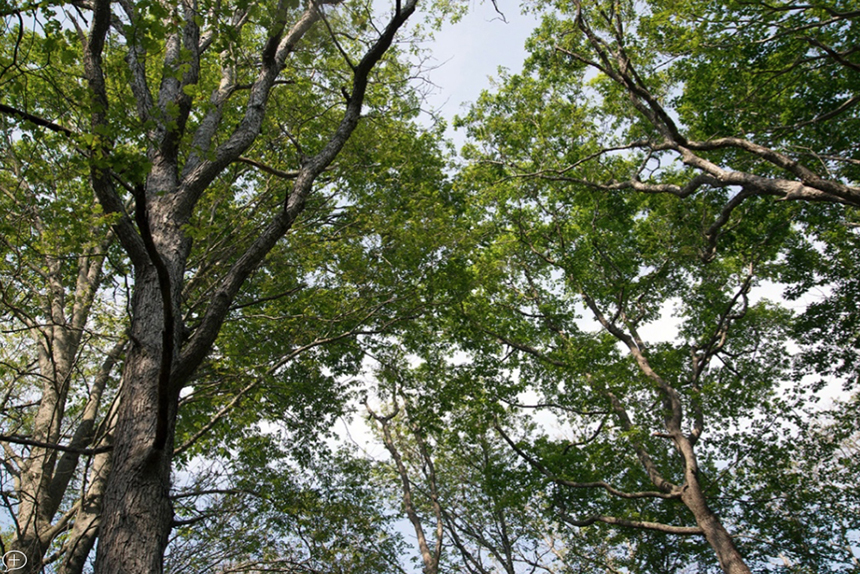By FRANK CARINI/ecoRI
News staff
 |
| Forests, like this one that covers Dundery Brook Trail in Little Compton, R.I., play a significant role in Rhode Island’s economy. (ecoRI News) |
Despite being the second-most densely populated state, with 1,022 people per square mile — only New Jersey is more crowded — Rhode Island is nearly 60 percent forested. That fact is further obscured by the Ocean State’s 400 miles of renowned coastline.
While Narragansett Bay and the rest
of the state’s coastal waters play a celebrated role in the local economy, so
too do Rhode Island’s 400,000 acres of forestland, of which about 70 percent is
privately owned.
Forest products contribute more than
$700 million annually to the Rhode Island economy and support some 3,300 jobs,
according to Tee Jay Boudreau, deputy chief for the Rhode Island Department of
Management’s (DEM) Division of Forest Environment.
There’s also the recreational value
of these woodlands. For instance, DEM oversees 30 parks and management areas
that host 6 million visitors every year (that number includes repeat visitors)
and generate $1.7 billion annually.
“Rhode Island has a substantial forest-based economy,” Boudreau said. “Hunting is a major beast ... a positive for Rhode Island.”
He noted that 20,000 hunters spend
about $18 million annually on hunting-related business.
Boudreau recently took part in
a Grow Smart Rhode Island panel discussion
titled “Rhode Island Forests: Our Invisible Green Giant.”
The discussion, held during Grow Smart’s recent "Power of Place Summit" at the Rhode Island Convention Center, also featured Bill Buffum, a research associate in the University of Rhode Island’s Department of Natural Resources Science, and Christopher Riely, coordinator of the Rhode Island Woodland Partnership. The talk was moderated by Christopher Modisette, state resource conservationist for the U.S. Department of Agriculture.
The discussion, held during Grow Smart’s recent "Power of Place Summit" at the Rhode Island Convention Center, also featured Bill Buffum, a research associate in the University of Rhode Island’s Department of Natural Resources Science, and Christopher Riely, coordinator of the Rhode Island Woodland Partnership. The talk was moderated by Christopher Modisette, state resource conservationist for the U.S. Department of Agriculture.
Prior to European settlement, Rhode
Island’s landscape looked vastly different, as about 95 percent of the state
was forested, according to the Rhode Island Woodland Partnership.
When settlers arrived, Buffum noted,
Rhode Island’s forests were quickly converted to agricultural land — the
state's collection of stone walls is a lasting reminder — leaving only 37
percent of the state forested by 1767. By 1870, only 25 percent of the state
was forestland. Rhode Island’s woods have since made a comeback, with a high of
66 percent coverage in 1953.
Trees now cover 56 percent of the
17th-most forested state, and Rhode Island’s woodlands remain a vital economic
resource. For example, about 30 percent of the state’s private forest
landowners have had commercial harvesting activity on their property.
The annual gross state output of
Rhode Island’s forest products industry totals nearly $710 million, and the
state’s forest-based recreation economy generates about $375 million annually,
according to a 2015 study the Economic Importance of Rhode
Island’s Forest Based Economy.
Some 3,325 workers are employed in
the forest products, maple and Christmas tree sectors, and another 1,500 jobs
are found in the sectors that include and support the forest recreation
economy, according to the 20-page study produced by the North
East State Foresters Association.
The forestry and logging sectors of
the state’s forest-based economy move logs, pulpwood, firewood or chips from
the forest to their primary manufacturing market. Payroll for forestry and
logging in Rhode Island, including, for example, operators of mobile sawmills,
exceeds $1.2 million annually, according to the 2015 study. The value of sales
from the state’s 19 registered logging operations is about $2 million annually.
The Rhode Island Woodland
Partnership began in April 2013 as an informal gathering of loggers, foresters,
conservationists, arborists and artisan woodworkers — people who cared about
forest health but were largely working independently.
Some five years later, this
now-formal partnership is working to increase the scale and pace of forestry in
Rhode Island. The partnership has created a networking space for Rhode Island’s
conservation community to stay abreast of issues impacting the region’s
forests.
The group’s working mission is to “advance the stewardship and long-term protection of Rhode Island’s woodlands to benefit the local economy, ecological values, and community enjoyment and health.”
The group’s working mission is to “advance the stewardship and long-term protection of Rhode Island’s woodlands to benefit the local economy, ecological values, and community enjoyment and health.”